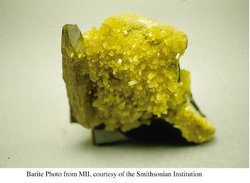Barite

| Topics: |
Geology (main)
|
Contents
Background
Barite is a mineral composed of barium sulfate, BaSO4. It is usually colorless or milky white, but can be almost any color, depending on the impurities trapped in the crystals during their formation. Barite is relatively soft, measuring 3-3.5 on Mohs' scale of hardness. It is unusually heavy for a non-metallic mineral. The high density is responsible for its value in many applications. Barite is chemically inert and insoluble.
Name
Barite (spelled baryte in British publications) was named from the Greek word baros which means weighty, a reference to its unusually high specific gravity. (Specific gravity is a mineralogist’s measure of the density of a mineral; this is done by comparing the weight of the mineral to the weight of an equal volume of water.)
Sources
Most barite is mined from layers of sedimentary rock which formed when barite precipitated onto the bottom of the ocean. Some smaller mines utilize barite from veins, which formed when barium sulfate was precipitated from hot subterranean waters. In some cases, barite is a by-product of mining lead, zinc, silver, or other metal ores.
There are nine barite mines in the United States; in Nevada, Georgia, Tennessee, and Missouri. China produces nearly ten times as much barite as the U.S., and India also produces more. About 40 other countries are also producers.
Many barite deposits are known worldwide, but some are uneconomic because barite can be mined more cheaply in China.
Uses
By far, the principal use for barite is as a “weighting agent” in oil and natural gas drilling. In this process, barite is crushed and mixed with water and other materials. It is then pumped into the drill hole. The weight of this mixture counteracts the force of the oil and gas when it is released from the ground. This allows the oil and gas rig operators to prevent the explosive release of the oil and gas from the ground. Currently, the majority of barite consumption in the United States is for this drilling application. However, the consumption in drilling "mud" fluctuates from year to year, as it is dependent on the amount of exploration drilling for oil and gas, which in turn depends on oil and gas prices.
Beyond this, barite is used as an additive to paints, enamels, and plastics, in the production of so-called "lead" crystal or "leaded" glass, stops radiation from computer monitors and television tubes, and as the source of barium chemicals.
Barite has the unique ability to strongly absorb X-rays and gamma rays. Consequently, it is used in medical science for special X-ray tests on the intestines and colon. It is also mixed with cement to make special containers used to store radioactive materials. A more recent application of barite is in the production of brake pads and clutches for cars and trucks.
Substitutes, Alternative source
Possible substitutes for barite, especially in the oil drilling industry, include other similar minerals, such as celestite (strontium sulfate, SrSO4) and iron ore. A German company is producing synthetic iron ore (hematite) which is proving a good substitute for barite. However, these alternatives have yet to be widely used in the oil industry, and barite continues to be the preferred commodity for this application as long as barite production remains strong.
Further Reading
- Common Minerals and Their Uses, Mineral Information Institute.
- More than 170 Mineral Photographs, Mineral Information Institute.
| Disclaimer: This article is taken wholly from, or contains information that was originally published by, the Mineral Information Institute. Topic editors and authors for the Encyclopedia of Earth may have edited its content or added new information. The use of information from the Mineral Information Institute should not be construed as support for or endorsement by that organization for any new information added by EoE personnel, or for any editing of the original content. |